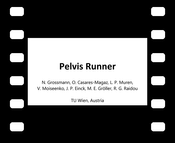Information
- Publication Type: Conference Paper
- Workgroup(s)/Project(s):
- Date: September 2019
- Lecturer: Nicolas Grossmann
- Event: Eurographics Workshop on Visual Computing for Biology and Medicine (2019)
- DOI: 10.2312/vcbm.20191233
- Call for Papers: Call for Paper
- Booktitle: Eurographics Workshop on Visual Computing for Biology and Medicine (2019)
- Pages: 69 – 78
Abstract
In radiation therapy, anatomical changes in the patient might lead to deviations between the planned and delivered dose--including inadequate tumor coverage, and overradiation of healthy tissues. Exploring and analyzing anatomical changes throughout the entire treatment period can help clinical researchers to design appropriate treatment strategies, while identifying patients that are more prone to radiation-induced toxicity. We present the Pelvis Runner, a novel application for exploring the variability of segmented pelvic organs in multiple patients, across the entire radiation therapy treatment process. Our application addresses (i) the global exploration and analysis of pelvic organ shape variability in an abstracted tabular view and (ii) the local exploration and analysis thereof in anatomical 2D/3D views, where comparative and ensemble visualizations are integrated. The workflow is based on available retrospective cohort data, which incorporate segmentations of the bladder, the prostate, and the rectum through the entire radiation therapy process. The Pelvis Runner is applied to four usage scenarios, which were conducted with two clinical researchers, i.e., medical physicists. Our application provides clinical researchers with promising support in demonstrating the significance of treatment plan adaptation to anatomical changes.Additional Files and Images
Weblinks
BibTeX
@inproceedings{raidou_2019_pelvisrunner,
title = "Pelvis Runner: Visualizing Pelvic Organ Variability in a
Cohort of Radiotherapy Patients",
author = "Nicolas Grossmann and Oscar Casares-Magaz and Ludvig Paul
Muren and Vitali Moiseenko and John P. Einck and Eduard
Gr\"{o}ller and Renata Raidou",
year = "2019",
abstract = "In radiation therapy, anatomical changes in the patient
might lead to deviations between the planned and delivered
dose--including inadequate tumor coverage, and overradiation
of healthy tissues. Exploring and analyzing anatomical
changes throughout the entire treatment period can help
clinical researchers to design appropriate treatment
strategies, while identifying patients that are more prone
to radiation-induced toxicity. We present the Pelvis Runner,
a novel application for exploring the variability of
segmented pelvic organs in multiple patients, across the
entire radiation therapy treatment process. Our application
addresses (i) the global exploration and analysis of pelvic
organ shape variability in an abstracted tabular view and
(ii) the local exploration and analysis thereof in
anatomical 2D/3D views, where comparative and ensemble
visualizations are integrated. The workflow is based on
available retrospective cohort data, which incorporate
segmentations of the bladder, the prostate, and the rectum
through the entire radiation therapy process. The Pelvis
Runner is applied to four usage scenarios, which were
conducted with two clinical researchers, i.e., medical
physicists. Our application provides clinical researchers
with promising support in demonstrating the significance of
treatment plan adaptation to anatomical changes.",
month = sep,
event = "Eurographics Workshop on Visual Computing for Biology and
Medicine (2019)",
doi = "10.2312/vcbm.20191233",
booktitle = "Eurographics Workshop on Visual Computing for Biology and
Medicine (2019)",
pages = "69--78",
URL = "https://www.cg.tuwien.ac.at/research/publications/2019/raidou_2019_pelvisrunner/",
}


